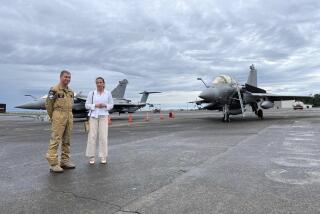Philippine Base Talks Recess; Issues in Limbo : Military: U.S. and Filipino negotiators differ sharply but agree to meet again in a month.
- Share via
MANILA — The huge U.S. air and naval bases in the Philippines were left in limbo Friday as negotiators concluded four days of often tense talks with no apparent agreement except to meet again.
U.S. and Philippine spokesmen could not even agree on the status of a Philippine proposal to take over three key Pentagon communications facilities and a military rest and recreation center complete with mountainside villas and an 18-hole golf course.
At a press conference, Philippine spokesman Rafael Alunan III insisted that the Philippines will take control of the four installations on Sept. 17, 1991, a day after an agreement governing the bases expires.
“They will revert to Philippine control,” Alunan said. “They will be 101% Philippine.”
But U.S. spokesman Stanley Schrager said there was no such agreement.
“It’s a proposal,” he said. “To the best of my knowledge no decision has been made.”
The facilities are little-known, but they play a key role in Pentagon operations in the Pacific. They include the U.S. Navy master fleet communications and relay station at San Miguel, about 60 miles north of Manila; the Air Force communications and electronic warfare system at nearby Camp O’Donnell, and an air-defense radar complex and reserved communications circuits facility at Wallace Air Station, about 145 miles north of Manila.
Camp John Hay, named for the U.S. secretary of state during America’s colonial war here 90 years ago, serves as a rest and recreation center for U.S. forces in the Pacific. Designed to resemble a resort in New York’s Adirondacks, it hugs a cool mountain plateau in the earthquake-ravaged province of Baguio.
U.S. special negotiator Richard L. Armitage and Philippine Foreign Minister Raul Manglapus agreed to meet again in Manila in about a month. But they ended the most recent session with vastly different proposals on the fate of Clark Air Base and the Subic Bay Naval Base, the two big installations here.
On Thursday, Manglapus proposed taking full “sovereign control” of Clark, now headquarters for the U.S. 13th Air Force, “as soon as possible” after the 1947 bases treaty expires next September, Alunan said. Moreover, he warned, the Philippine government will study ways to dismantle the bases if no agreement is reached by next January.
One member of the U.S. negotiating team said the proposals “shocked, horrified, appalled and surprised” Armitage and his aides. The United States did not offer a specific counterproposal, however.
Instead, Armitage proposed Friday a 10-to-12-year “phase-down,” or reduction of troops and operations, at Subic Bay, which services the 7th Fleet. Even after the transition, Armitage said, the Pentagon wants broad access to dry dock and ship repair facilities, jungle warfare and pilot training facilities, and other operations into the indefinite future.
The Philippine side did not respond.
“This week was a week of proposals and counterproposals,” Schrager said. He said the negotiators did not discuss possible U.S. compensation for use of the facilities, at present $481 million a year.
Schrager said Armitage did not specify how and where the cuts would be made, but another American said the Pentagon hopes to keep up to 5,000 service personnel at Clark and Subic, “and the capability to build back up if we should need to in the future.”
U.S. strength at Clark is now 9,200; at Subic, 6,200, and at the four other facilities in the Philippines, about 200. About 2,500 will be withdrawn within two years in any case under a White House plan to reduce the U.S. military presence in East Asia.
Armitage left Manila for Tokyo at midafternoon to brief Japanese officials on the talks. U.S. officials said the stop was an indication of the bases’ regional importance in guarding sea lanes.
“We do not want to appear like we’re packing up, or closing up shop in the region,” one U.S. official explained. “It’s important that we maintain a sense of stability.”
A State Department warning of an “imminent terrorist bombing” keyed to the talks did not materialize. But riot police fired tear gas and water hoses to disperse hundreds of anti-bases demonstrators who gathered late Friday near the U.S. Embassy. Several in the crowd tossed small homemade bombs, but no serious injuries or damage were reported.
More to Read
Sign up for Essential California
The most important California stories and recommendations in your inbox every morning.
You may occasionally receive promotional content from the Los Angeles Times.













